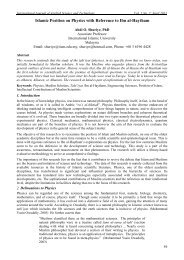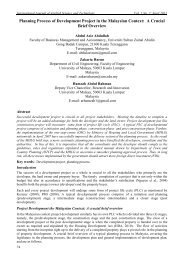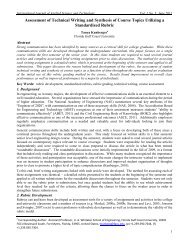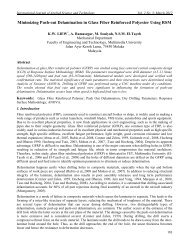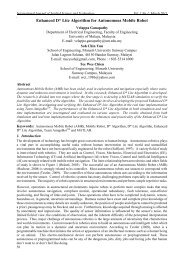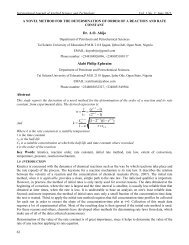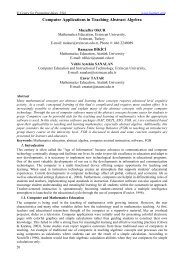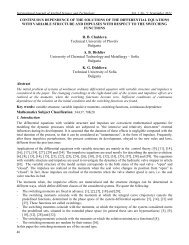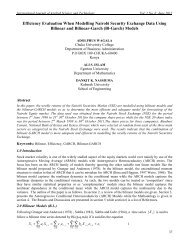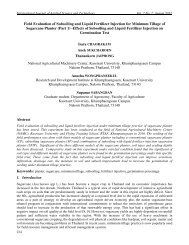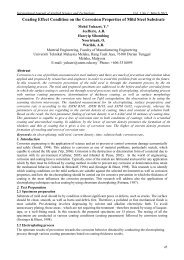Preparation and Theoretical Study of some Transition Metal ...
Preparation and Theoretical Study of some Transition Metal ...
Preparation and Theoretical Study of some Transition Metal ...
Create successful ePaper yourself
Turn your PDF publications into a flip-book with our unique Google optimized e-Paper software.
© Centre for Promoting Ideas, USA www.ijastnet .com<br />
2.3 <strong>Preparation</strong> <strong>of</strong> the lig<strong>and</strong><br />
A- L1= (N,N-Dimethyl Propargyl amine) , L2= (N,N- Propargyl Piperidine ),<br />
were prepared according to the literature (5)<br />
B- L3= ( N,N- Propargyl Morpholine ), L4= ( N,N- Methyl -N- Propargyl benzyl<br />
amine ), were prepared according to the method (6) . the lig<strong>and</strong>s are listed in table(1).<br />
2.4 General Procedure for <strong>Preparation</strong> <strong>of</strong> Complexes<br />
All <strong>of</strong> complexes were prepared by the following methods; A solution <strong>of</strong> the lig<strong>and</strong> (2 mmole/l) in absolute<br />
ethanol wee prepared <strong>and</strong> reacted with various metal chlorides in the required molar ratio. To a solution <strong>of</strong> (L)<br />
(2 mmole/l) in absolute ethanol ,a hot ethanolic solution (96%) containing (1 mmole/l) <strong>of</strong> CrCl 3 .6H 2 O was<br />
gradually added with sting the product .the color <strong>of</strong> the resultant mixture changed immediately , the mixture<br />
was left over night . a colored solid precipitate was separated <strong>and</strong> colleted by filtration under vacuo, then it<br />
was washed successively with ethanol <strong>and</strong> recrystallized from absolute ethanol/ether to give colored<br />
complexes . Analogous complexes were prepared in a similar manner to that described above by adding a hot<br />
solution <strong>of</strong> metal chloride (MoCl 5 .6H 2 O or WCl 6 .6H 2 O ) (1 mmole/l) to a solution <strong>of</strong> lig<strong>and</strong> (2 mmole/l) . the<br />
complexes are listed in table(2).<br />
2.5- <strong>Study</strong> <strong>of</strong> biological activity for lig<strong>and</strong>s <strong>and</strong> their metal complexes<br />
The biological activity <strong>of</strong> the lig<strong>and</strong>s <strong>and</strong> their metal complexes were studied against two selected type <strong>of</strong><br />
bacteria which included Escherichia coli as gram negative (-Ve) <strong>and</strong> Staphylococcus aureus as gram positive<br />
(+Ve) to be cultivated <strong>and</strong> as control for the disc sensitivity test (9) , this method involves the exposure <strong>of</strong> the<br />
zone <strong>of</strong> inhibition toward the diffusion <strong>of</strong> micro–organism on agar plat. The plates were incubated for (24<br />
hours) , at 37C° , the zone <strong>of</strong> inhibition <strong>of</strong> bacteria growth around the disc was observed.<br />
3. RESULT AND DISCUSION<br />
3.1 IR Spectra<br />
The spectra <strong>of</strong> all prepared complexes were prepared with lig<strong>and</strong> spectra in the region (4000-200) cm -1 .<br />
stretching vibration <strong>of</strong> (C≡C) bonds for the prepared lig<strong>and</strong> appear near (2100) cm -1 (13) . This peak will shifted<br />
to lower frequency by (490) cm -1 (i.e. to 1750-1650) cm -1 the peak which belong to the frequency (C≡C)<br />
disappeared producing the change in lig<strong>and</strong> peak shape <strong>and</strong> appear intensity more than complex as shown in<br />
table(1). υ M-N frequency appears in the region (315-345) cm -1 which indicating the involving <strong>of</strong> nitrogen<br />
atoms in coordination with metallic ion. In addition, new b<strong>and</strong>s appears attributed to the M-Cl stretching<br />
vibration table(2).<br />
3.2. Electronic Spectra<br />
UV-Visible spectra for the prepared lig<strong>and</strong> show two b<strong>and</strong>s, the first b<strong>and</strong> at (319) nm <strong>and</strong> the second at<br />
(372) nm as shown in table (1).comparing the UV-Vis for free lig<strong>and</strong> solution with metal complexes ,clear<br />
sudden change have been made in b<strong>and</strong>s spots weather increasing o decreasing in wavelength or by new<br />
absorbance b<strong>and</strong> for all preparation complex which belong coordination complex formation ,the change in<br />
color we occurred after mix lig<strong>and</strong>s solution with metal salt, the mixtures color differ free lig<strong>and</strong> <strong>and</strong> metal<br />
salt colors indicate occurring complexation , the data in table (2) clearly show that that b<strong>and</strong>s in all complexes<br />
appear shifted in λmax, compared to the same b<strong>and</strong>s in the free lig<strong>and</strong> signs this b<strong>and</strong> is due to (π-π*) <strong>and</strong>(nπ*)<br />
<strong>and</strong> this shifted in λmax can be to indicate the complexation between lig<strong>and</strong> <strong>and</strong> metal ions (14) .<br />
3.3. Magnetic <strong>Study</strong><br />
From table(2) the magnetic susceptibility were experimentally measured for (Cr +3 , Mo +5 <strong>and</strong> W +6 ) complexes<br />
were correspondences with theoretical data for its complexes (coordination number six) with octahedral<br />
structure (15) .<br />
3.4. Molar Conductance<br />
The measurements <strong>of</strong> the molar electrical conductivity <strong>of</strong> the complexes in DMSO solvent are prepared in<br />
table (2). The results clearly show the high values for the molar conductivity <strong>of</strong> the complexes <strong>of</strong> metal ions<br />
are electrolyte.<br />
3.5. Stoichiometric <strong>Study</strong><br />
Molar ratio (1:2) lig<strong>and</strong> to metal (ML 2 ) was also obtained for the complexes by molar-ratio method as shown<br />
in fig.(1).<br />
42



